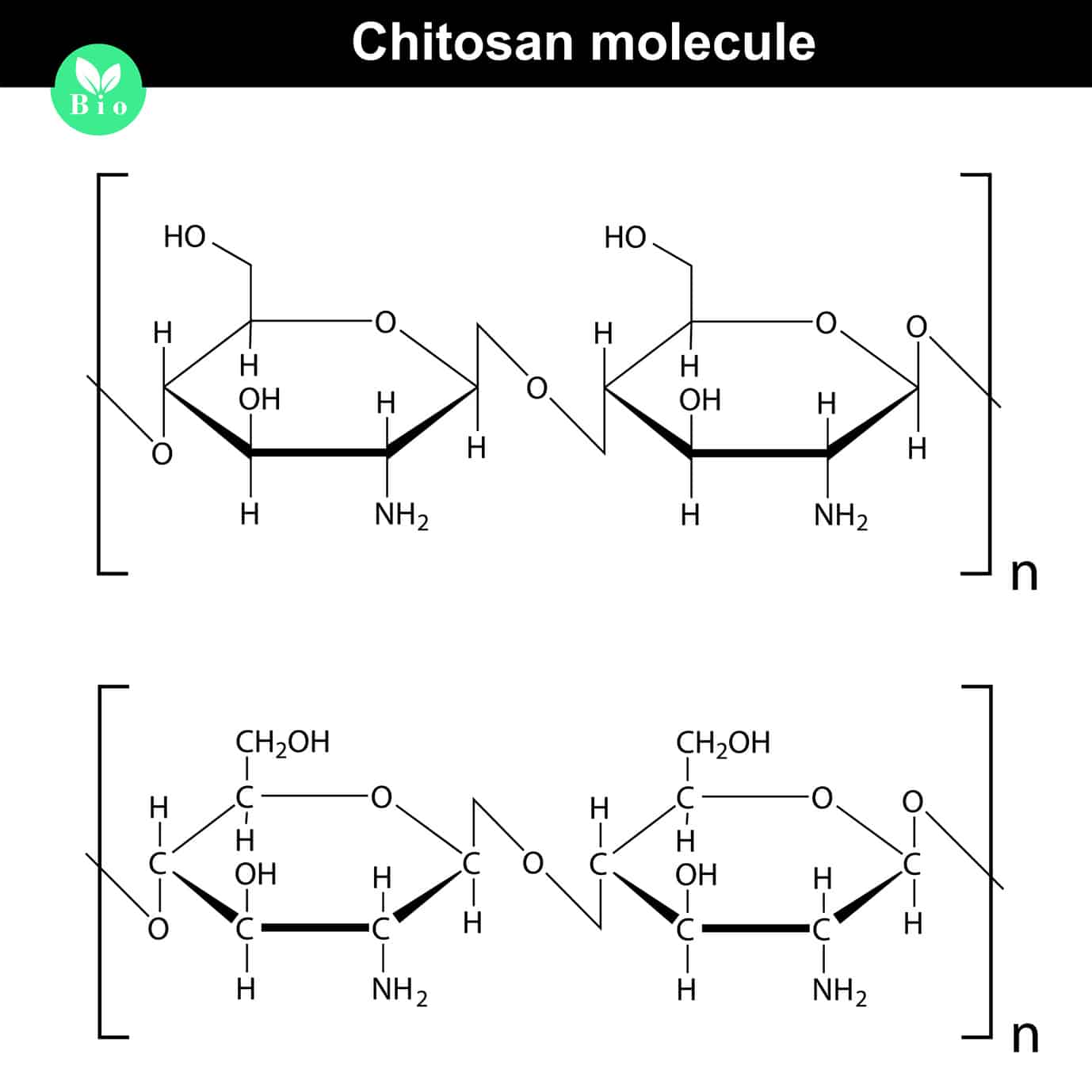Polyglucosamine

Properties and benefits of polyglucosamine
According to studies, polyglucosamine can be lipid-lowering. The substance binds lipids contained in food, inhibiting their absorption. It does this by trapping them in a type of gel and excreting them with the stool. The substance is also said to be able to lower LDL and increase HDL. Polyglucosamine binds the negatively charged fatty acids and is itself positively charged. It swells very well with water and therefore has a slightly satiating effect and shortens intestinal transit time. Its ability to bind fats has already been demonstrated in vitro. Polyglucosamine is now very popular for weight control, as an effective fat binder to support a therapy for obesity, and as a lipid-lowering agent to reduce LDL and cholesterol. In addition, polyglucosamine can form insoluble complexes, especially with heavy metals, because as a so-called chelating agent it can attach itself to a larger number of ions simultaneously, virtually like a tapeworm with numerous tiny suction cups.
The substance usually has only minor side effects. Occasionally, nausea, flatulence or constipation may occur after taking the corresponding dietary supplements. It is not advisable to take the substance if you are allergic to shellfish: after all, the substance is found in abundance in the shells of crustaceans such as crabs, shrimps and crayfish.
But the substance is also increasingly being used in cosmetics. The properties of polyglucosamine are so diverse that the substance has now also attracted the interest of the cosmetics industry. It is hemostatic, anti-bacterial, anti-mycotic and can bind heavy metals. It is of great importance as an active component in skin care products.
Positive properties of polyglucosamine in cosmetics
Superficial wounds such as small scrapes, scratches and abrasions heal faster because the substance promotes wound healing. Possible inflammation of superficial wounds is prevented thanks to its anti-bacterial properties. On smooth surfaces, the substance forms a film that is not visible and only barely noticeable, but still effectively protects the skin from drying out. In addition, polyglucosamine relieves itching as well as the accompanying symptoms of sunburn and insect bites. The superficially damaged skin caused by itching calms down, is kept sufficiently moist by the protective film and thus heals better and faster. In addition, the chemical structure of the substance acts as a kind of buffer by stabilizing the skin’s natural acid mantle. It reliably attaches itself to the skin’s own collagen and thus ensures that regrowing cells have an optimal foundation. Skin cells in cell culture grow in a significantly more structured manner in the presence of a polyglucosamine matrix. Polyglucosamine is used in the cosmetic sector primarily for oral and dental care products, hair care products and skin care products. It is also increasingly found in lotions and deodorants.
In toothpaste it is an optimal embedding agent for electron microscopy, and in material for contact lenses it is used as an artificial tear fluid. It is ideal for wound closures after dental surgery or, for example, in the treatment of periodontitis-related tooth bed damage.
And in general, polyglucosamine plays a major role in medicine. The substance is an excellent degradable surgical filler (especially in orthopedics, ophthalmology, and dentistry), is used as a degradable suture material for artificial vessels, and helps with intentional delayed drug release.
Polyglucosamine is biodegradable, easy to use and of biological origin, yet without TSE risk (generic term for central nervous diseases of some mammalian species).
Overall, therefore, it is a biopolymer with almost unbelievable capabilities. Hardly any other natural substance is as effective and versatile as the one from which, among other things, the protective shells of many beetle species and the shells of crustaceans and crustaceans are made.
But even when used in cosmetic products, side effects cannot be completely ruled out. However, these are primarily allergic reactions. Skin rash, urticaria and itching are possible side effects. Nevertheless, the positive properties and the high benefit of polyglucosamine outweigh the side effects.
Vegan chitosan
Now it has finally succeeded, by a patented procedure vegan Chitosan is won from mushrooms.
It has identical, positive properties as the previous chitosan, which was obtained from the waste of crustaceans and can now be used for vegan products. However, the smell is much better and the fishy undertone in the smell is a thing of the past. It is now ECOCERT certified, non-GMO, halal compliant and ISO 16128 compliant.
We offer the development of natural cosmetics with vegan chitson and can develop a product with chitosan for your brand in a fitting and valuable way.
Fact Sheet Polyglucosamine
INCI: Chitosan
CAS number: 9012-76-4
Description: light beige, linear polysaccharide, a colorless, amorphous, viscous substance.
Physical state: solid
Class of active ingredients: lipid absorber, wound healing
Solubility: insoluble in water at pH greater than 6.4
See here the raw materials containing chitosan that we like to work with:
| Trade Name | Company Name | INCI | Comment |
|---|---|---|---|
| Chitosan-HD | Sandream Specialties | Chitosan | |
| VAMACTIVE KIT | Sharon Laboratories Ltd | Chitosan PCA | |
| CD-58 | Onlystar Bio-Technology Co., Ltd | Chitosan Succinamide | |
| CHITOGLYCAN PF | Sinerga | Carboxymethyl Chitosan | |
| Chitosan, fungal origin | Kraeber & Co. GmbH | Chitosan | vegan |
Polyglucosamine: more than just a slimming agent
The lipid-lowering agent polyglucosamine now has an excellent reputation as a slimming agent, but it can also excellently develop its many positive properties in cosmetics. From dental and oral care products to hair setting agents and protective skin care products, the substance opens up a wide range of applications. Due to its binding, smoothing and even growth-promoting properties, it can be used in many cosmetic products. We will be happy to advise you on the possible applications of chitosan.
Sources:
Chitosan as a Wound Dressing Starting Material: Antimicrobial Properties and Mode of Action.; Int J Mol Sci. 2019 Nov 24;20(23):5889.
Cosmetics and Cosmeceutical Applications of Chitin, Chitosan and Their Derivatives.; Polymers (Basel). 2018 Feb 22;10(2):213.
Preparation and Antimicrobial Activity of Chitosan and Its Derivatives: A Concise Review.; Molecules. 2021 Jun 17;26(12):3694.
Lemongrass (Cymbopogon citratus)-incorporated chitosan bioactive films for potential skincare applications.; Gaspar AL, Gaspar AB, Contini LRF, Silva MF, Chagas EGL, Bahú JO, Concha VOC, Carvalho RA, Severino P, Souto EB, Lopes PS, Yoshida CMP. Int J Pharm. 2022 Nov 25;628:122301.
Recent approach of metal binding by chitosan and derivative.; Domard, E. Piron, Adv. Chitin Sci. 4, 295 – 301, 2000
Photocrosslinkable Chitosan Hydrogel as a Wound Dressing and a Biological Adhesive.; Ishihara, M. Trends in Glycoscience and Glycotechnology, Vol.14 No.80 (November 2002) pp.331–341
